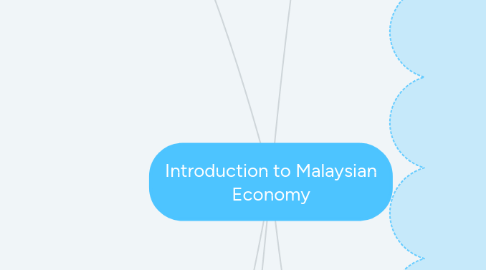
1. Malaysia Economic Policy Framework
1.1. Short-term planning - Annual Budget Medium-term planning - Five-year development plans. e.g. 8th Malaysian Plan Long term planning - Outline Perspective Plan 1 @OPP1 (1971 – 1990) - based on National Economic Policy (NEP) OPP2 (1991 – 2000) - based on NATIONAL DEVELOPMENT POLICY (NDP) OPP3 (2001 – 2010) - NATIONAL VISION POLICY (NVP) Vision 2020 (1991 – 2020)
2. Fiscal Policy
2.1. aggressively using money as an injection to of millions and billions of ringgit into the economic system of the country to boost grow and stability.
2.2. a tool of the government to control inflation and recession.
2.3. Inflation = increase in the prices
2.4. Recession = a period when economy of a country is not very successful
3. Economic Policy in Malaysia
3.1. NATIONAL VISION POLICY (NVP)
3.1.1. Focus on building a resilient and competitive nation
3.1.2. Incorporates the past key strategies
3.1.3. Some of the Objective 1. National unity. 2. Poverty eradication. 3. Socioeconomic restructuring. 4. Enhancing competitiveness to meet the challenges of globalization and liberalization of the economy.
3.2. NATIONAL DEVELOPMENT POLICY (NDP)
3.2.1. NDP = extension of the NEP. Most of the policies and plans for socio-economic restructuring and poverty eradication plus additional objectives in order to achieve of Wawasan 2020
3.2.2. Some objectives of NDP: To achieve national unity, harmony & integrity. To restructure the society through socioeconomic restructuring. To minimize poverty level in the country To promote science and technology as the platform for modern development.
3.3. MAIN FOCUS OF NDP Macroeconomic stability. Poverty reduction & socio-economy restructuring. Productivity-driven growth. Enhance competitiveness.
3.4. Main Principles 1. Creating k-economy. 2. Privatization. 3. Education.
3.5. NEW ECONOMIC POLICY (NEP)
3.5.1. Was due to wide gap in the economic development between Bumiputera and Non-Bumiputera
3.5.2. Three main objectives of NEP: To achieve national unity, harmony and integrity. To restructure the society through socio-economic restructuring. To minimize the level of poverty in the country.
3.6. New economic model
3.6.1. intended to more than double the per capita income
3.6.2. The goal to "transform the Malaysian economy to become one with high incomes and quality growth" by 2020
3.6.3. The keys to the plan are high income, sustainability and inclusiveness
4. Introduction
4.1. Economy: Development of a country in achieving growth, economic development
4.2. Economics: Production, distribution and consumption of goods and services
4.3. Economic Activities Primary sector = agricultural , forestry, fishing, mining & quarrying. Secondary sector = manufacturing & construction Tertiary sector = all service activities
4.4. Economic Structure Refers to the composition of economic activities which related to primary, secondary and tertiary sectors.
5. Economic Growth vs. Economic Development
5.1. Economic Growth refers to increase overtime in a country’s real output of goods and services (real output per capita GNP). Focus more on quantitative measures.
5.2. Economic Development refers to the progress towards reducing the incidence of poverty, unemployment, and income inequalities. Focus more on qualitative measures.
5.3. Gross National Product (GNP) a accumulation of the values of finished products and services by a given state in one year, but does not include unfinished products/ goods
5.3.1. GDP = consumption + gross investment + government spending + (exports − imports)
5.3.2. GDP measures all domestic production, disregarding the producing entities' nationalities
5.3.3. takes into income of all local people who are working overseas but send back money or its value home
5.4. Components of Economic Growth 1.Capital accumulation 2.Growth in population 3. Technological programs 4. Labor saving
5.5. Why economic growth and development is important to developing countries?
5.5.1. will show a real output of goods and services (GNP per capita).
5.5.2. reflects to the availability efforts towards development
5.5.3. involves elements such as employment, literacy rate, health care, poverty and equal distribution, which is bases for development efforts.
5.5.4. will indicate the progress towards reducing the incidents of poverty, unemployment and income inequality.
5.6. Economic problems in developing countries
5.6.1. Over population
5.6.2. Lack of infrastructures
5.6.3. High and rising levels of unemployment
5.6.4. Low level of productivity.
5.7. Factors Contributed Towards Development of Malaysian Economy
5.7.1. Availability of natural resources
5.7.2. Availability of skilled & unskilled work force
5.7.3. Good governance/ policies
5.7.4. Political stability
